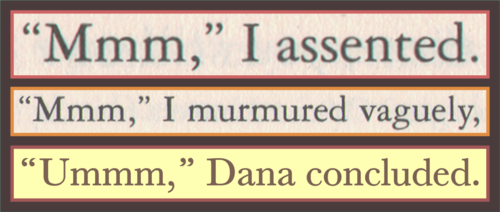There has been a lot of talk, and online writing, about dialogue in fiction this past week. The issue seemed to be divided between two distinct groups. Group One: these grammarians believe that you should only use the word said after any character statement. Group Two: these grammarians believe that you should use as many dialogue tags as possible.
What is a dialogue tag? You ask. Pretty much any other verb that describes a section of dialogue than said. These verbs are often in the past tense, meaning they end in -ed.
- She screamed
- He murmured
- They trumpeted
- Ze giggled
And so forth, and so on. People in Group One find this type of usage onerous. And there are clear reasons why they should. Books ala the Twilight Series take dialogue tags to lofty new levels that might crush even the most adventurous dialoguers spirit. If you, my dear reader, would like to take a look at some examples, I recommend the Reasoning with Vampires tumblr. It is hilarious. 
Did you like the above sample? There are a lot more examples on the RWV blog. After reading prose with such flowery dialogue tags, part of me agrees with Group One. After all, said blends into the background. It allows the conversation between the characters to flow without being interrupted by the infamous telling, not showing.
The problem with Group One’s assertion: it gets boring. If people only say things, I feel that the full range of emotions isn’t being expressed. Sure, you can probably tell there’s a fight going on in the scene without people snarling and hissing, at each other, but sometimes it’s nice to have that extra modifier to let you know what’s going on in the character’s head.
What happens if you have a normally monotone character, then suddenly, they burst into song. Something like that would be a shock, so using a good dialogue tag is a great way to show the out of character nature of the situation.
“The hills are alive.” He caterwauled, paints a much brighter picture than, “The hills are alive!” He said. Even with the exclamation point thrown in there, the first example has a stronger meaning. It just sings out. (Sorry, sometimes I can’t help myself.)
I find myself falling in between the two groups. When I write fiction, I use both. For the most part, my dialogue tags are of the plain, ole, boring said variety. There are occasions that I use other verbs, mostly when I want to put emphasis on something, or subtly (at least I hope so) point the reader to an important plot point.
What do you all think? Do you prefer Group One, Group Two, or a mix of both. There is no right or wrong answer. Do you all have a favorite dialogue tag? I happen to love warbled.
Thanks for reading, please share.
I’m definitely more in the first camp. I’d rather that the tags be invisible or even omitted. All the busy stretching for variety can get in the way of the dialog itself. Using a tag other than ‘said’ is a spice that needs to be used sparingly.
Agreed. Except when trying to be silly.
I’m totally in camp one. I think if you want to get caterwaul on the page there are way better ways to do it than using that single, unpacked word as a tag. Unless you want to use it with a little tongue in cheek.
Since I write cheesy mysteries, I often employ tongue in cheek! Mostly, I just use said, and let the story tell itself.
Ejaculated. And no, I’ve never actually used it in my writing.
Why do you even need ‘said’? If you absolutely need said all the time, you need to think more about how your characters speak. Huckleberry Finn’s dialog would never be mistaken for the words of Sherlock Holmes. Perhaps there should be some distinctive things about how your characters talk. Of course, you want to use as light a touch as possible, or it quickly turns into a joke.
The corollary here, is the more people talking, the more you need to use ‘said’. One person talking to himself: unneeded. Two people: use it to establish a patter pattern, then drop them. Fifty persons all speaking out of turn: use ‘said’ with every line of dialog.
I like dialog tags to work for me. A character might sputter or mutter if I want to remind the reader that he’s been trying to hide the crown jewels in his mouth during the whole conversation. I’m also more likely to use them in adverse conditions. Shouted, hollered, screamed, and so on will be fairly liberally used on the deck of a ship during a severe storm.
Ultimately, if I feel the need to use a descriptive dialog tag, that’s probably a sign that I need to take a small dialog break and describe a little bit of action, and do that instead. If it’s not totally necessary, drop it, but make sure the dialog is just as interesting without it.
That is your task! Use it in writing sometime, even if you cut it later. It looks like most people are in Group One, with a dash of Group two. I love the comments!